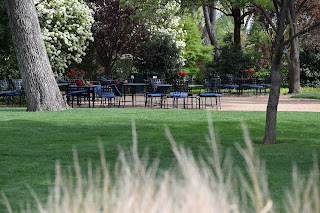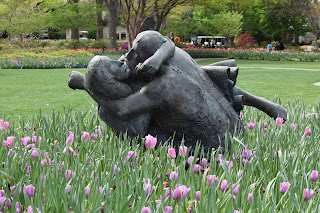Header
Sunday, March 31, 2019
Saturday, March 16, 2019
3-Day Travel Itinerary in Madrid
Video 1. Span Travel Skills
Video 2. 25 Things to Do in Madrid
Video 3. Madrid Travel Guide
 |
Figure 1. 3-Day Travel Itinerary around Gran Via
|
Gran Via
Gran Vía (literally "Great Way") is a street located in central Madrid, Spain. It leads from Calle de Alcalá, close to Plaza de Cibeles, to Plaza de España.
The street, sometimes referred to as the "Spanish Broadway", is one of the city's most important shopping areas, with a large number of hotels and large movie theatres; however, in recent years, many of these theatres have been replaced by shopping centres.
Day 1
Walking 5 mins from Plaza del Callao to Puerta Del Sol.
The Puerta del Sol (Spanish for "Gate of the Sun") is a public square in Madrid, one of the best known and busiest places in the city. This is the centre (Km 0) of the radial network of Spanish roads.
Walking 5 mins from Puerta Del Sol to Plaza Mayor:
The Plaza Mayor has been the scene of multitudinous events: markets (Christmas Market), bullfights, soccer games, public executions, etc. The Plaza Mayor also has a ring of old and traditional shops and cafes under its porticoes. Celebrations for San Isidro (patron saint of Madrid) are also held here.
Taking lunch at Mercado De San Micuel:
Established in 1916, Mercado de San Miguel is one of the oldest and most alluring markets in Madrid. With its stunning 20th-century glass walls, it could easily be considered among the finest examples of iron and glass architecture in the Spanish capital, alongside the city’s Crystal Palace in Parque del Buen Retiro.
Walking 7 minutes from Mercado De San Micuel to Royal Palace of Madrid:
Built on the site of a former alcazar between 1760 and 1764, the palace stands as a jewel in the city’s shiny royal crown. Surrounded by Plaza de la Armeria, the charming park of Campo del Moro, the Sabatini Gardens, Plaza de Armas, and the magnificent Plaza de Oriente, with its stunning collection of Spanish Kings statues, the Royal Palace of Madrid is as beautiful and impressive outside as it is inside.
Walking to the nearby Sabatini Gardens:
The Sabatini Gardens (Jardínes de Sabatini) are a neoclassical-style gardens, and they are part of the Royal Palace. The Sabatini Gardens are a perfect spot for a restful break during the exhausting sightseeing tours in Madrid. They offer spectacular views of the North façade of the Royal Palace, vegetal mazes, sculptures and tons of tranquility.
Walking to the nearby Almudena Cathedral:
The Cathedral is 104 m long and 76 m wide. The central dome has a diameter of 20 m. The building is situated adjacent to the Royal Palace, in front of "Plaza de Armas" of the Palace, on the south side.Enjoying Madrid Nightlife
The bright interior of Almudena Cathedral is based in the Neo-Gothic style, that it is uniquely modern, with chapels and statues of contemporary artists, in heterogeneous styles, from historical revivals to "pop-art" decor.
- Joining a tour from Madride Pub Crawl for:
- Bar hopping
- Flamingo Dancing at Las Tablas Club
- Churro at Churreria Chocolateria (Los Artesanos since 1902)
Day 2
Starting at corner of Calle de Alcala to view Metropolis Building:
Perhaps the most photographed sight in Madrid, the Metropolis Building is a beautiful office center situated on the corner of Calle de Alcala and Gran Via, in the heart of the city.Walking 4 minutes to Plaza de Cibeles:
Plaza de Cibeles is a symbol of Madrid and the setting of such notable attractions as the legendary Cibeles Fountain, the outstanding Cybele Palace, also known as the Palace of Communication, the beautiful Bank of Spain, the Linares Palace, and the Buenavista Palace.
The museum is housed in a beautiful 19th century Neo-classical mansion (Villahermosa Palace) and focuses on the private collections of art of Baron Heinrich Thyssen-Bornemisza and his son, Baron Hans Heinrich Thyssen-Bornemisza.
Opened in 1992 on the site of an old hospital, and dedicated to the 20th-century art, Museo Nacional Centro de Arte Reina Sofía is one of the finest museums in Madrid.
The Prado Museum (Museo Nacional del Prado) is Madrid’s top cultural attraction and undeniably the most famous museum in Spain.
The Prado Museum (Museo Nacional del Prado) is Madrid’s top cultural attraction and undeniably the most famous museum in Spain.
Finally, you can wrap up day 2 with visiting Buen Retiro Park:
Buildings and Tourist Attractions:
Close to the northern entrance of the park is a large artificial lake, the Retiro Pond. Next to it is the monument to King Alfonso XII, featuring a semicircular colonnade and an equestrian statue of the monarch on the top of a tall central core.
The Rosaleda Garden. Among the many rose bushes of all kinds stands the Fountain of the Falling Angel (1922), which represents Lucifer falling from Heaven. It is claimed that this statue is the only known public monument of the devil. More to the south is another, much smaller lake. At the edge of the lake is a beautiful glass building, the Palacio de Cristal. Built in 1887, it was initially used to house exotic plants. It is now mainly used for temporary exhibitions. Nearby is another pavilion, the Palacio de Velázquez, designed in 1884. Now also used for temporary exhibitions, it originally served as a pavilion for the national exhibition of the mining, metal, glass and ceramics industry.
Day 3
Visiting two neighborhood:
Salamanca is a quiet, but upscale neighborhood offering chic dining options, historic architecture, and prime luxury real estate.
Malasana
Bubbling with life at any time of day – and often long into the night – Malasaña is Madrid’s hippest neighbourhood.
Madrid locals know an ideal way to enjoy the city is to spend a day hanging out in one of the city’s many barrios; eating, drinking, relaxing in the park or shopping in the boutiques. And in Malasaña you can get a bit of history and culture as well.
Finally, don't forget to get up to the top of El Corte Ingles Plaza Del Callao:
Spain’s major department store, El Corte Inglés, first opened in the 1940’s. Today, many of us Spaniards love El Corte Inglés as it sells virtually anything under the sun, from your laptop and underwear to your mattress and plane ticket. A little outdated indeed, one of the stores decided it was time for a facelift — a few months ago, the Corte Inglés in Callao converted the top floor into Gourmet Experience, a tantalizing food hall with stunning views of Madrid’s Gran Vía and the emblematic Shweppes sign.
References
- Spain Travel Skills
- What Are Tapas and Where Do They Come From?
- Scenic Spain: Madrid’s Best Nature Escapes
- donkey.bike
- Notes in Spanish
- 5 Days in Portugal Itinerary: Lisbon, Sintra, and Porto
- Money
- The best practical travel tips for Europe (good)
- Currency and payment methods in Spain
- ATMs at MAD airport
- Línea Exprés (the express bus) (line 203): Atocha railway station - Airport
- SPAIN TRAIN GUIDE – HOW TO TAVEL SPAIN BY TRAIN (good)
Subscribe to:
Posts (Atom)




























